Decarbonizing Electricity Systems: The Importance of Energy Storage
VerifiedAdded on 2022/11/30
|48
|12062
|427
Report
AI Summary
This report examines the crucial role of energy storage in decarbonizing electricity systems, focusing on enhancing the integration of renewable energy sources like wind power while reducing reliance on fossil fuels. It addresses the challenges of climate change and the need for innovative solutions in electricity production, highlighting how energy storage can provide operational flexibility, improve the utilization of renewable generation assets, and facilitate grid stability. The study reviews the current literature on decarbonization targets, the impact of renewable energy technologies, and the economic value of energy storage, considering factors such as cost, sustainability, and the reduction of greenhouse gas emissions. The analysis includes discussions on wind power's potential, the effects of relying exclusively on renewables, and the curtailment of renewable energy, ultimately emphasizing the significance of energy storage in achieving a carbon-free electricity sector. This document is available on Desklib, a platform offering study tools and resources for students.
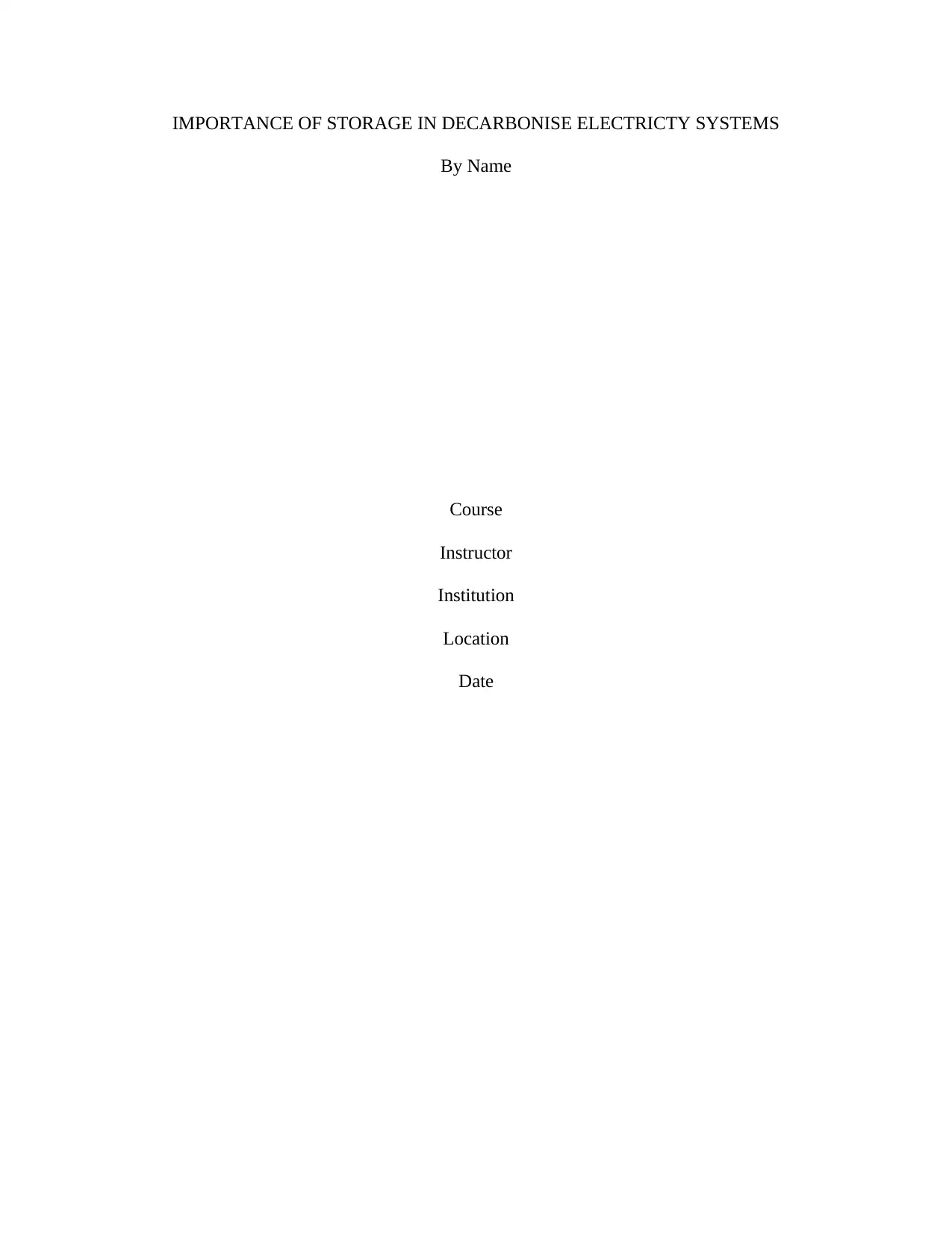
IMPORTANCE OF STORAGE IN DECARBONISE ELECTRICTY SYSTEMS
By Name
Course
Instructor
Institution
Location
Date
By Name
Course
Instructor
Institution
Location
Date
Paraphrase This Document
Need a fresh take? Get an instant paraphrase of this document with our AI Paraphraser
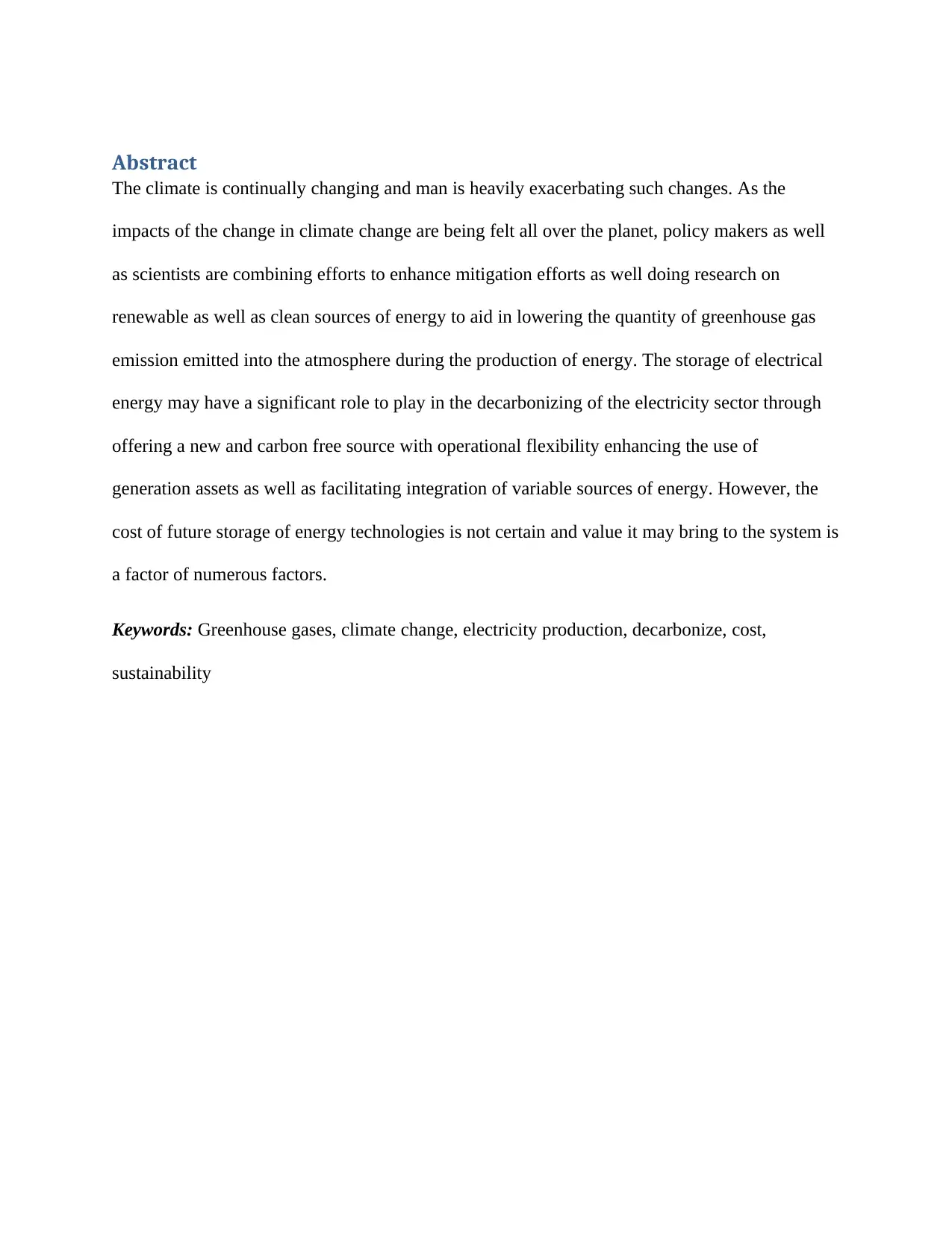
Abstract
The climate is continually changing and man is heavily exacerbating such changes. As the
impacts of the change in climate change are being felt all over the planet, policy makers as well
as scientists are combining efforts to enhance mitigation efforts as well doing research on
renewable as well as clean sources of energy to aid in lowering the quantity of greenhouse gas
emission emitted into the atmosphere during the production of energy. The storage of electrical
energy may have a significant role to play in the decarbonizing of the electricity sector through
offering a new and carbon free source with operational flexibility enhancing the use of
generation assets as well as facilitating integration of variable sources of energy. However, the
cost of future storage of energy technologies is not certain and value it may bring to the system is
a factor of numerous factors.
Keywords: Greenhouse gases, climate change, electricity production, decarbonize, cost,
sustainability
The climate is continually changing and man is heavily exacerbating such changes. As the
impacts of the change in climate change are being felt all over the planet, policy makers as well
as scientists are combining efforts to enhance mitigation efforts as well doing research on
renewable as well as clean sources of energy to aid in lowering the quantity of greenhouse gas
emission emitted into the atmosphere during the production of energy. The storage of electrical
energy may have a significant role to play in the decarbonizing of the electricity sector through
offering a new and carbon free source with operational flexibility enhancing the use of
generation assets as well as facilitating integration of variable sources of energy. However, the
cost of future storage of energy technologies is not certain and value it may bring to the system is
a factor of numerous factors.
Keywords: Greenhouse gases, climate change, electricity production, decarbonize, cost,
sustainability
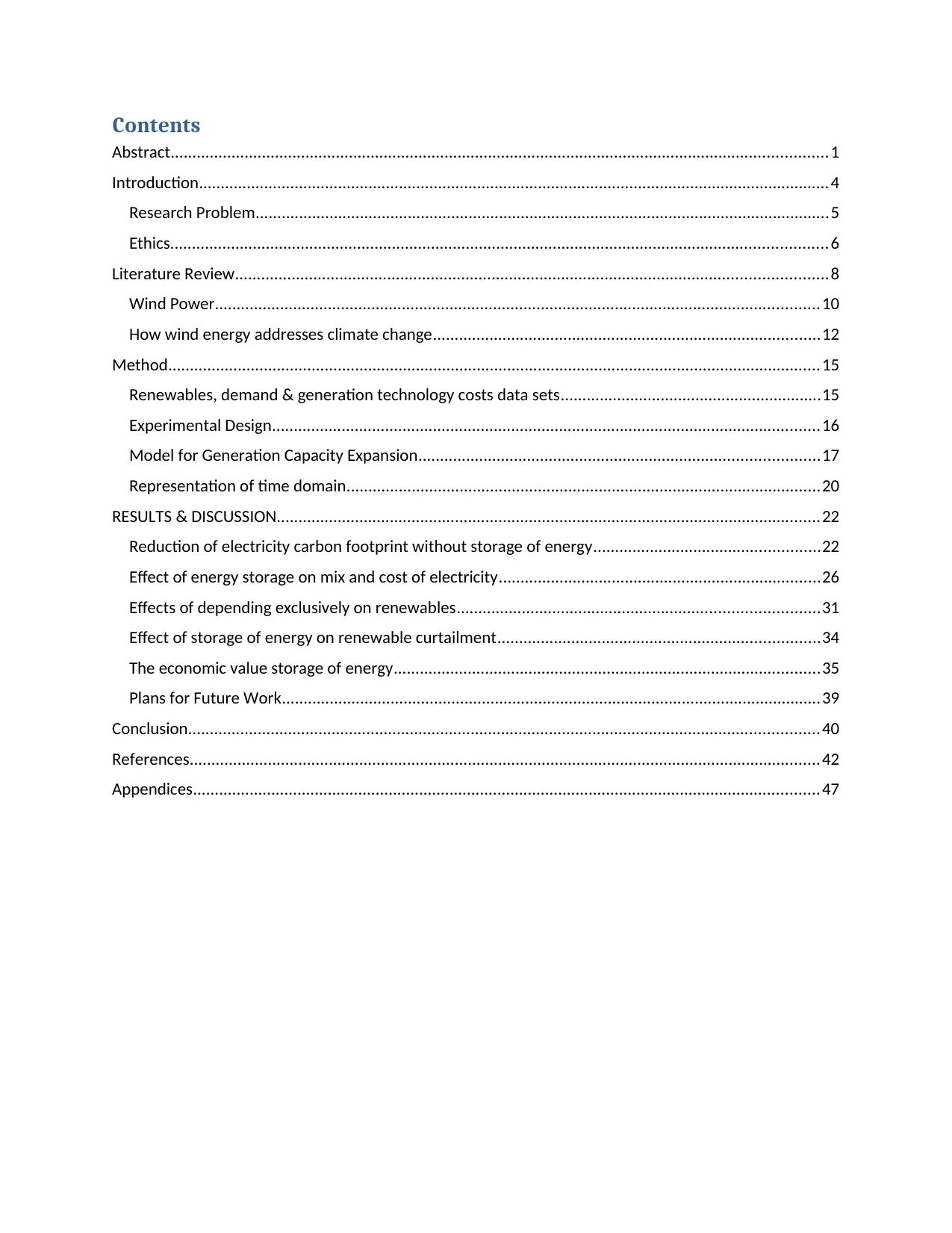
Contents
Abstract.......................................................................................................................................................1
Introduction.................................................................................................................................................4
Research Problem....................................................................................................................................5
Ethics.......................................................................................................................................................6
Literature Review........................................................................................................................................8
Wind Power...........................................................................................................................................10
How wind energy addresses climate change.........................................................................................12
Method......................................................................................................................................................15
Renewables, demand & generation technology costs data sets............................................................15
Experimental Design..............................................................................................................................16
Model for Generation Capacity Expansion............................................................................................17
Representation of time domain.............................................................................................................20
RESULTS & DISCUSSION.............................................................................................................................22
Reduction of electricity carbon footprint without storage of energy....................................................22
Effect of energy storage on mix and cost of electricity..........................................................................26
Effects of depending exclusively on renewables...................................................................................31
Effect of storage of energy on renewable curtailment..........................................................................34
The economic value storage of energy..................................................................................................35
Plans for Future Work............................................................................................................................39
Conclusion.................................................................................................................................................40
References.................................................................................................................................................42
Appendices................................................................................................................................................47
Abstract.......................................................................................................................................................1
Introduction.................................................................................................................................................4
Research Problem....................................................................................................................................5
Ethics.......................................................................................................................................................6
Literature Review........................................................................................................................................8
Wind Power...........................................................................................................................................10
How wind energy addresses climate change.........................................................................................12
Method......................................................................................................................................................15
Renewables, demand & generation technology costs data sets............................................................15
Experimental Design..............................................................................................................................16
Model for Generation Capacity Expansion............................................................................................17
Representation of time domain.............................................................................................................20
RESULTS & DISCUSSION.............................................................................................................................22
Reduction of electricity carbon footprint without storage of energy....................................................22
Effect of energy storage on mix and cost of electricity..........................................................................26
Effects of depending exclusively on renewables...................................................................................31
Effect of storage of energy on renewable curtailment..........................................................................34
The economic value storage of energy..................................................................................................35
Plans for Future Work............................................................................................................................39
Conclusion.................................................................................................................................................40
References.................................................................................................................................................42
Appendices................................................................................................................................................47
⊘ This is a preview!⊘
Do you want full access?
Subscribe today to unlock all pages.

Trusted by 1+ million students worldwide
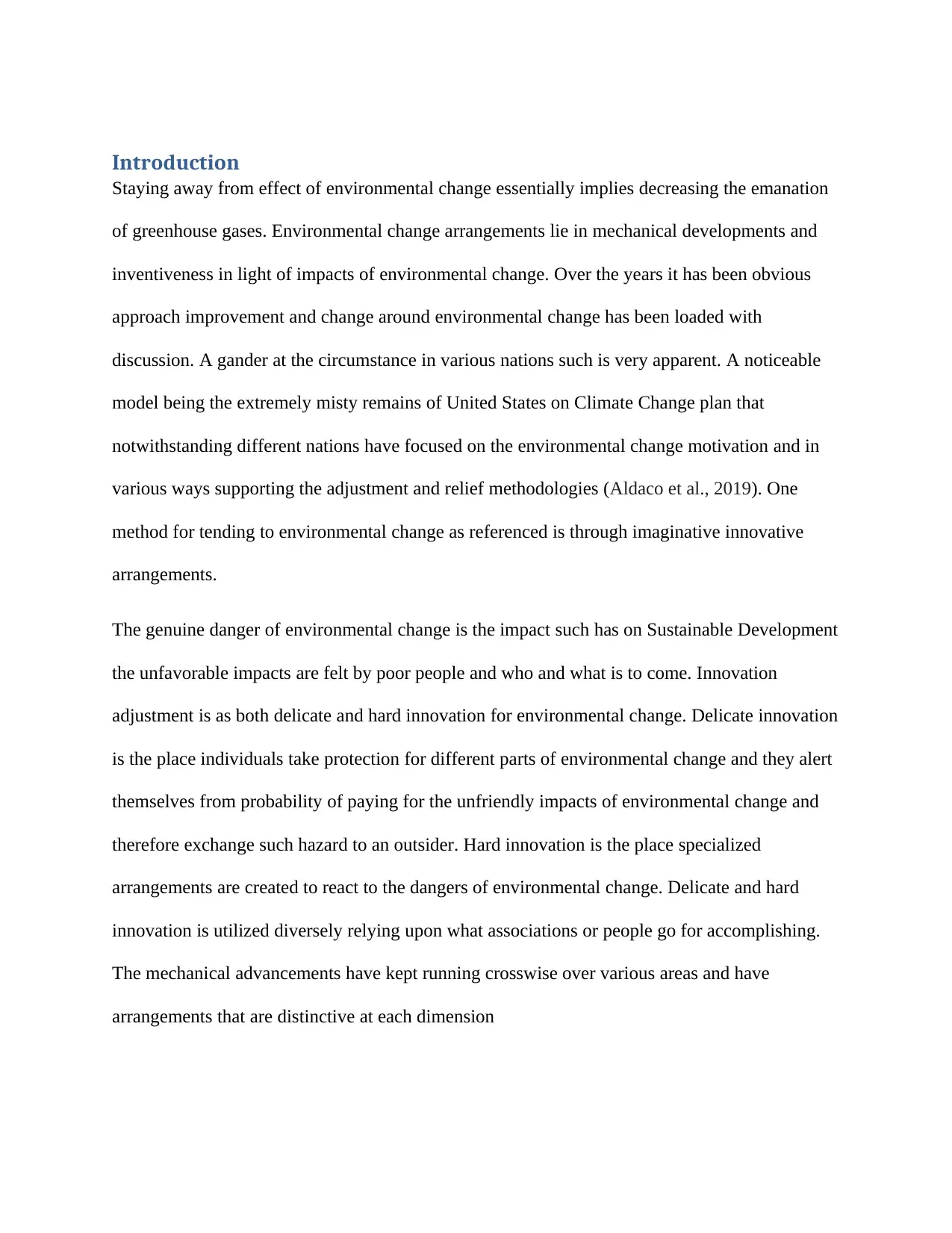
Introduction
Staying away from effect of environmental change essentially implies decreasing the emanation
of greenhouse gases. Environmental change arrangements lie in mechanical developments and
inventiveness in light of impacts of environmental change. Over the years it has been obvious
approach improvement and change around environmental change has been loaded with
discussion. A gander at the circumstance in various nations such is very apparent. A noticeable
model being the extremely misty remains of United States on Climate Change plan that
notwithstanding different nations have focused on the environmental change motivation and in
various ways supporting the adjustment and relief methodologies (Aldaco et al., 2019). One
method for tending to environmental change as referenced is through imaginative innovative
arrangements.
The genuine danger of environmental change is the impact such has on Sustainable Development
the unfavorable impacts are felt by poor people and who and what is to come. Innovation
adjustment is as both delicate and hard innovation for environmental change. Delicate innovation
is the place individuals take protection for different parts of environmental change and they alert
themselves from probability of paying for the unfriendly impacts of environmental change and
therefore exchange such hazard to an outsider. Hard innovation is the place specialized
arrangements are created to react to the dangers of environmental change. Delicate and hard
innovation is utilized diversely relying upon what associations or people go for accomplishing.
The mechanical advancements have kept running crosswise over various areas and have
arrangements that are distinctive at each dimension
Staying away from effect of environmental change essentially implies decreasing the emanation
of greenhouse gases. Environmental change arrangements lie in mechanical developments and
inventiveness in light of impacts of environmental change. Over the years it has been obvious
approach improvement and change around environmental change has been loaded with
discussion. A gander at the circumstance in various nations such is very apparent. A noticeable
model being the extremely misty remains of United States on Climate Change plan that
notwithstanding different nations have focused on the environmental change motivation and in
various ways supporting the adjustment and relief methodologies (Aldaco et al., 2019). One
method for tending to environmental change as referenced is through imaginative innovative
arrangements.
The genuine danger of environmental change is the impact such has on Sustainable Development
the unfavorable impacts are felt by poor people and who and what is to come. Innovation
adjustment is as both delicate and hard innovation for environmental change. Delicate innovation
is the place individuals take protection for different parts of environmental change and they alert
themselves from probability of paying for the unfriendly impacts of environmental change and
therefore exchange such hazard to an outsider. Hard innovation is the place specialized
arrangements are created to react to the dangers of environmental change. Delicate and hard
innovation is utilized diversely relying upon what associations or people go for accomplishing.
The mechanical advancements have kept running crosswise over various areas and have
arrangements that are distinctive at each dimension
Paraphrase This Document
Need a fresh take? Get an instant paraphrase of this document with our AI Paraphraser
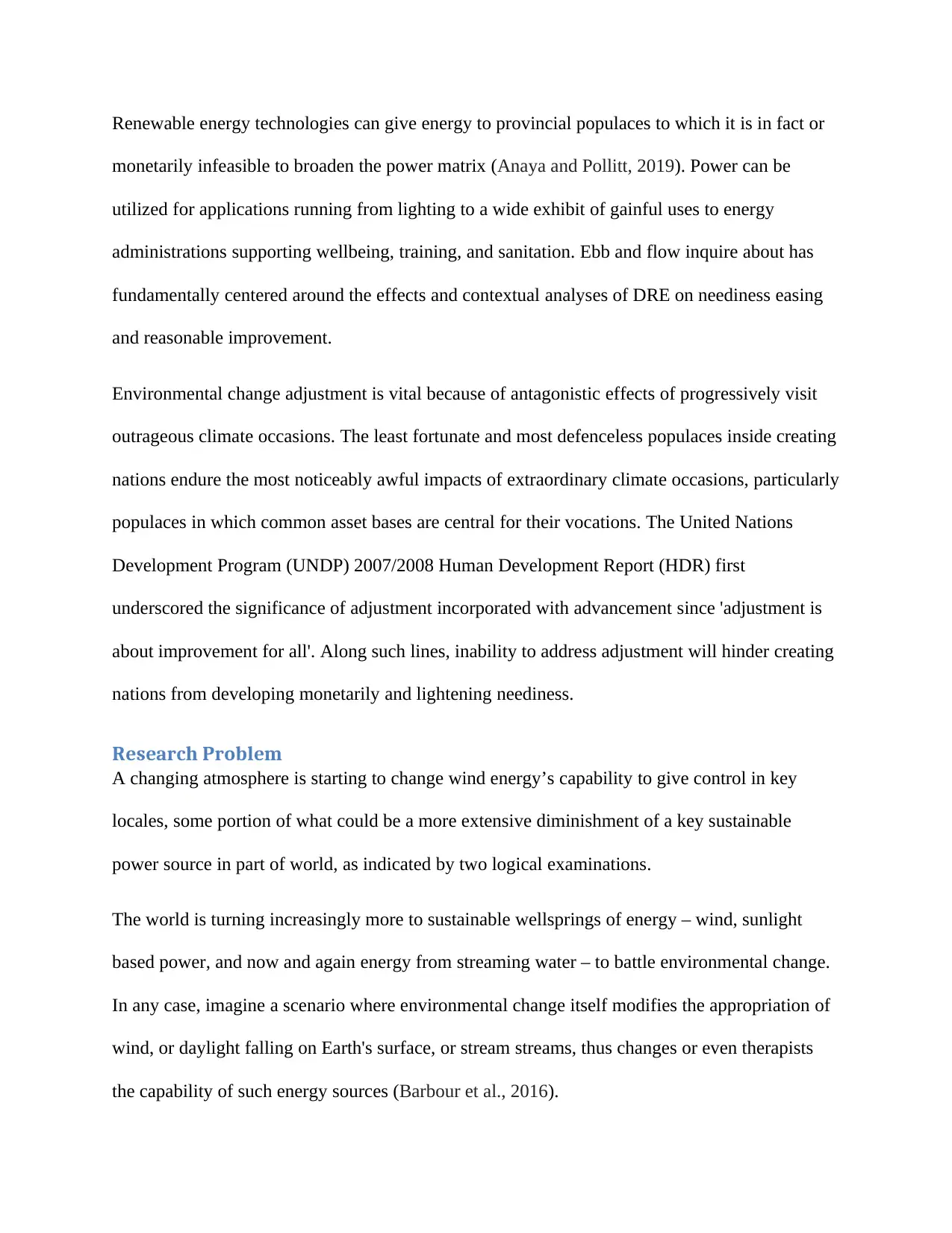
Renewable energy technologies can give energy to provincial populaces to which it is in fact or
monetarily infeasible to broaden the power matrix (Anaya and Pollitt, 2019). Power can be
utilized for applications running from lighting to a wide exhibit of gainful uses to energy
administrations supporting wellbeing, training, and sanitation. Ebb and flow inquire about has
fundamentally centered around the effects and contextual analyses of DRE on neediness easing
and reasonable improvement.
Environmental change adjustment is vital because of antagonistic effects of progressively visit
outrageous climate occasions. The least fortunate and most defenceless populaces inside creating
nations endure the most noticeably awful impacts of extraordinary climate occasions, particularly
populaces in which common asset bases are central for their vocations. The United Nations
Development Program (UNDP) 2007/2008 Human Development Report (HDR) first
underscored the significance of adjustment incorporated with advancement since 'adjustment is
about improvement for all'. Along such lines, inability to address adjustment will hinder creating
nations from developing monetarily and lightening neediness.
Research Problem
A changing atmosphere is starting to change wind energy’s capability to give control in key
locales, some portion of what could be a more extensive diminishment of a key sustainable
power source in part of world, as indicated by two logical examinations.
The world is turning increasingly more to sustainable wellsprings of energy – wind, sunlight
based power, and now and again energy from streaming water – to battle environmental change.
In any case, imagine a scenario where environmental change itself modifies the appropriation of
wind, or daylight falling on Earth's surface, or stream streams, thus changes or even therapists
the capability of such energy sources (Barbour et al., 2016).
monetarily infeasible to broaden the power matrix (Anaya and Pollitt, 2019). Power can be
utilized for applications running from lighting to a wide exhibit of gainful uses to energy
administrations supporting wellbeing, training, and sanitation. Ebb and flow inquire about has
fundamentally centered around the effects and contextual analyses of DRE on neediness easing
and reasonable improvement.
Environmental change adjustment is vital because of antagonistic effects of progressively visit
outrageous climate occasions. The least fortunate and most defenceless populaces inside creating
nations endure the most noticeably awful impacts of extraordinary climate occasions, particularly
populaces in which common asset bases are central for their vocations. The United Nations
Development Program (UNDP) 2007/2008 Human Development Report (HDR) first
underscored the significance of adjustment incorporated with advancement since 'adjustment is
about improvement for all'. Along such lines, inability to address adjustment will hinder creating
nations from developing monetarily and lightening neediness.
Research Problem
A changing atmosphere is starting to change wind energy’s capability to give control in key
locales, some portion of what could be a more extensive diminishment of a key sustainable
power source in part of world, as indicated by two logical examinations.
The world is turning increasingly more to sustainable wellsprings of energy – wind, sunlight
based power, and now and again energy from streaming water – to battle environmental change.
In any case, imagine a scenario where environmental change itself modifies the appropriation of
wind, or daylight falling on Earth's surface, or stream streams, thus changes or even therapists
the capability of such energy sources (Barbour et al., 2016).
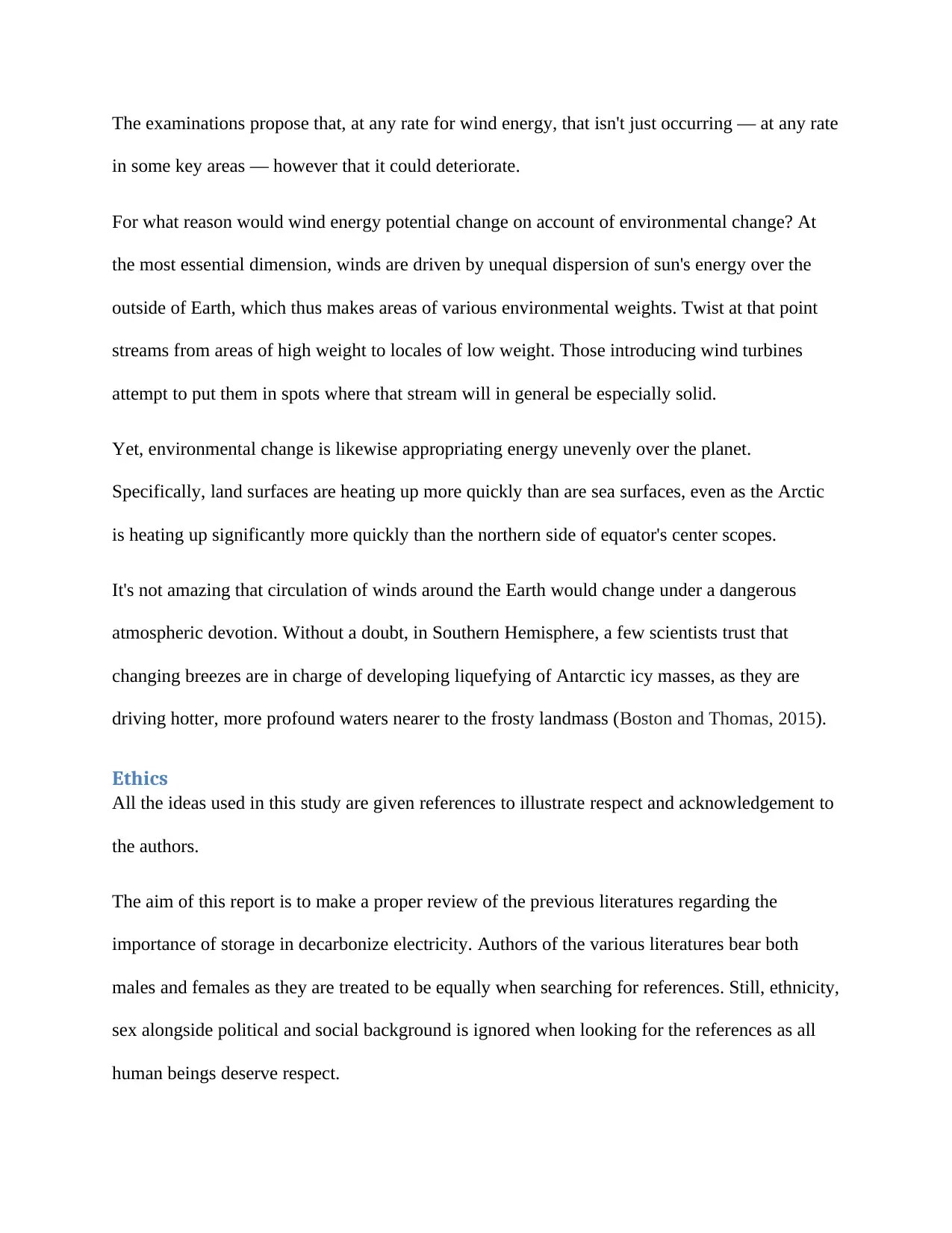
The examinations propose that, at any rate for wind energy, that isn't just occurring — at any rate
in some key areas — however that it could deteriorate.
For what reason would wind energy potential change on account of environmental change? At
the most essential dimension, winds are driven by unequal dispersion of sun's energy over the
outside of Earth, which thus makes areas of various environmental weights. Twist at that point
streams from areas of high weight to locales of low weight. Those introducing wind turbines
attempt to put them in spots where that stream will in general be especially solid.
Yet, environmental change is likewise appropriating energy unevenly over the planet.
Specifically, land surfaces are heating up more quickly than are sea surfaces, even as the Arctic
is heating up significantly more quickly than the northern side of equator's center scopes.
It's not amazing that circulation of winds around the Earth would change under a dangerous
atmospheric devotion. Without a doubt, in Southern Hemisphere, a few scientists trust that
changing breezes are in charge of developing liquefying of Antarctic icy masses, as they are
driving hotter, more profound waters nearer to the frosty landmass (Boston and Thomas, 2015).
Ethics
All the ideas used in this study are given references to illustrate respect and acknowledgement to
the authors.
The aim of this report is to make a proper review of the previous literatures regarding the
importance of storage in decarbonize electricity. Authors of the various literatures bear both
males and females as they are treated to be equally when searching for references. Still, ethnicity,
sex alongside political and social background is ignored when looking for the references as all
human beings deserve respect.
in some key areas — however that it could deteriorate.
For what reason would wind energy potential change on account of environmental change? At
the most essential dimension, winds are driven by unequal dispersion of sun's energy over the
outside of Earth, which thus makes areas of various environmental weights. Twist at that point
streams from areas of high weight to locales of low weight. Those introducing wind turbines
attempt to put them in spots where that stream will in general be especially solid.
Yet, environmental change is likewise appropriating energy unevenly over the planet.
Specifically, land surfaces are heating up more quickly than are sea surfaces, even as the Arctic
is heating up significantly more quickly than the northern side of equator's center scopes.
It's not amazing that circulation of winds around the Earth would change under a dangerous
atmospheric devotion. Without a doubt, in Southern Hemisphere, a few scientists trust that
changing breezes are in charge of developing liquefying of Antarctic icy masses, as they are
driving hotter, more profound waters nearer to the frosty landmass (Boston and Thomas, 2015).
Ethics
All the ideas used in this study are given references to illustrate respect and acknowledgement to
the authors.
The aim of this report is to make a proper review of the previous literatures regarding the
importance of storage in decarbonize electricity. Authors of the various literatures bear both
males and females as they are treated to be equally when searching for references. Still, ethnicity,
sex alongside political and social background is ignored when looking for the references as all
human beings deserve respect.
⊘ This is a preview!⊘
Do you want full access?
Subscribe today to unlock all pages.

Trusted by 1+ million students worldwide
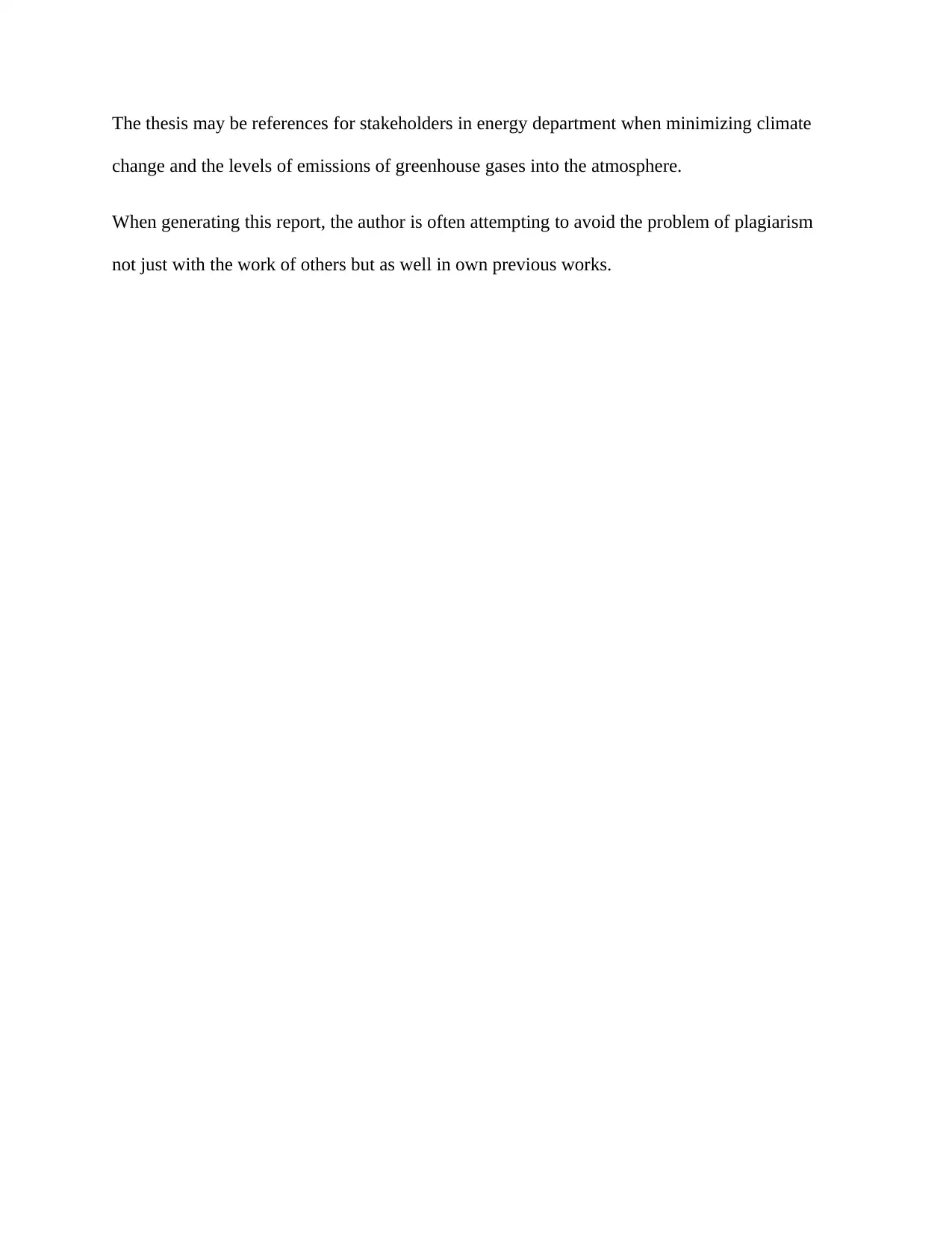
The thesis may be references for stakeholders in energy department when minimizing climate
change and the levels of emissions of greenhouse gases into the atmosphere.
When generating this report, the author is often attempting to avoid the problem of plagiarism
not just with the work of others but as well in own previous works.
change and the levels of emissions of greenhouse gases into the atmosphere.
When generating this report, the author is often attempting to avoid the problem of plagiarism
not just with the work of others but as well in own previous works.
Paraphrase This Document
Need a fresh take? Get an instant paraphrase of this document with our AI Paraphraser
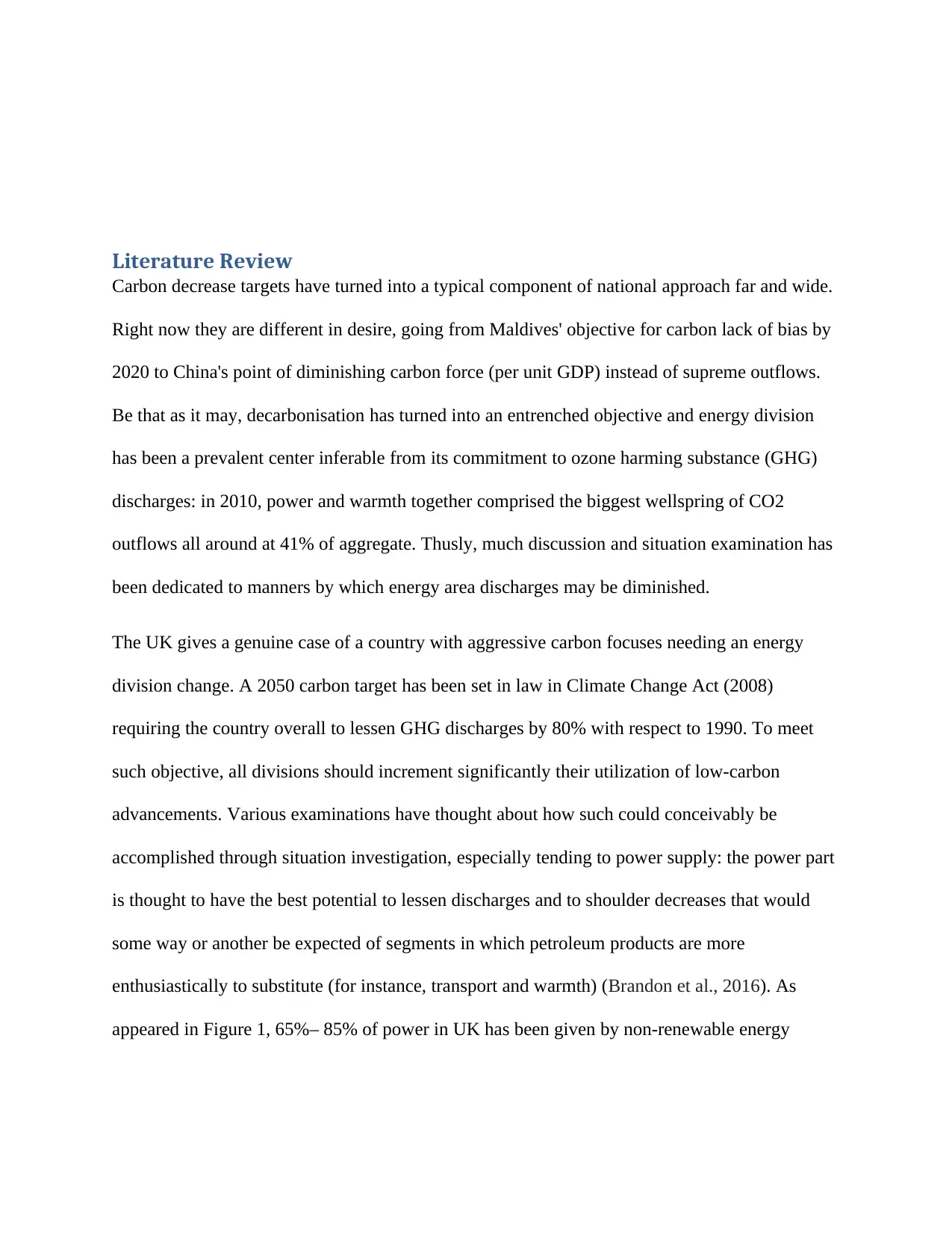
Literature Review
Carbon decrease targets have turned into a typical component of national approach far and wide.
Right now they are different in desire, going from Maldives' objective for carbon lack of bias by
2020 to China's point of diminishing carbon force (per unit GDP) instead of supreme outflows.
Be that as it may, decarbonisation has turned into an entrenched objective and energy division
has been a prevalent center inferable from its commitment to ozone harming substance (GHG)
discharges: in 2010, power and warmth together comprised the biggest wellspring of CO2
outflows all around at 41% of aggregate. Thusly, much discussion and situation examination has
been dedicated to manners by which energy area discharges may be diminished.
The UK gives a genuine case of a country with aggressive carbon focuses needing an energy
division change. A 2050 carbon target has been set in law in Climate Change Act (2008)
requiring the country overall to lessen GHG discharges by 80% with respect to 1990. To meet
such objective, all divisions should increment significantly their utilization of low-carbon
advancements. Various examinations have thought about how such could conceivably be
accomplished through situation investigation, especially tending to power supply: the power part
is thought to have the best potential to lessen discharges and to shoulder decreases that would
some way or another be expected of segments in which petroleum products are more
enthusiastically to substitute (for instance, transport and warmth) (Brandon et al., 2016). As
appeared in Figure 1, 65%– 85% of power in UK has been given by non-renewable energy
Carbon decrease targets have turned into a typical component of national approach far and wide.
Right now they are different in desire, going from Maldives' objective for carbon lack of bias by
2020 to China's point of diminishing carbon force (per unit GDP) instead of supreme outflows.
Be that as it may, decarbonisation has turned into an entrenched objective and energy division
has been a prevalent center inferable from its commitment to ozone harming substance (GHG)
discharges: in 2010, power and warmth together comprised the biggest wellspring of CO2
outflows all around at 41% of aggregate. Thusly, much discussion and situation examination has
been dedicated to manners by which energy area discharges may be diminished.
The UK gives a genuine case of a country with aggressive carbon focuses needing an energy
division change. A 2050 carbon target has been set in law in Climate Change Act (2008)
requiring the country overall to lessen GHG discharges by 80% with respect to 1990. To meet
such objective, all divisions should increment significantly their utilization of low-carbon
advancements. Various examinations have thought about how such could conceivably be
accomplished through situation investigation, especially tending to power supply: the power part
is thought to have the best potential to lessen discharges and to shoulder decreases that would
some way or another be expected of segments in which petroleum products are more
enthusiastically to substitute (for instance, transport and warmth) (Brandon et al., 2016). As
appeared in Figure 1, 65%– 85% of power in UK has been given by non-renewable energy
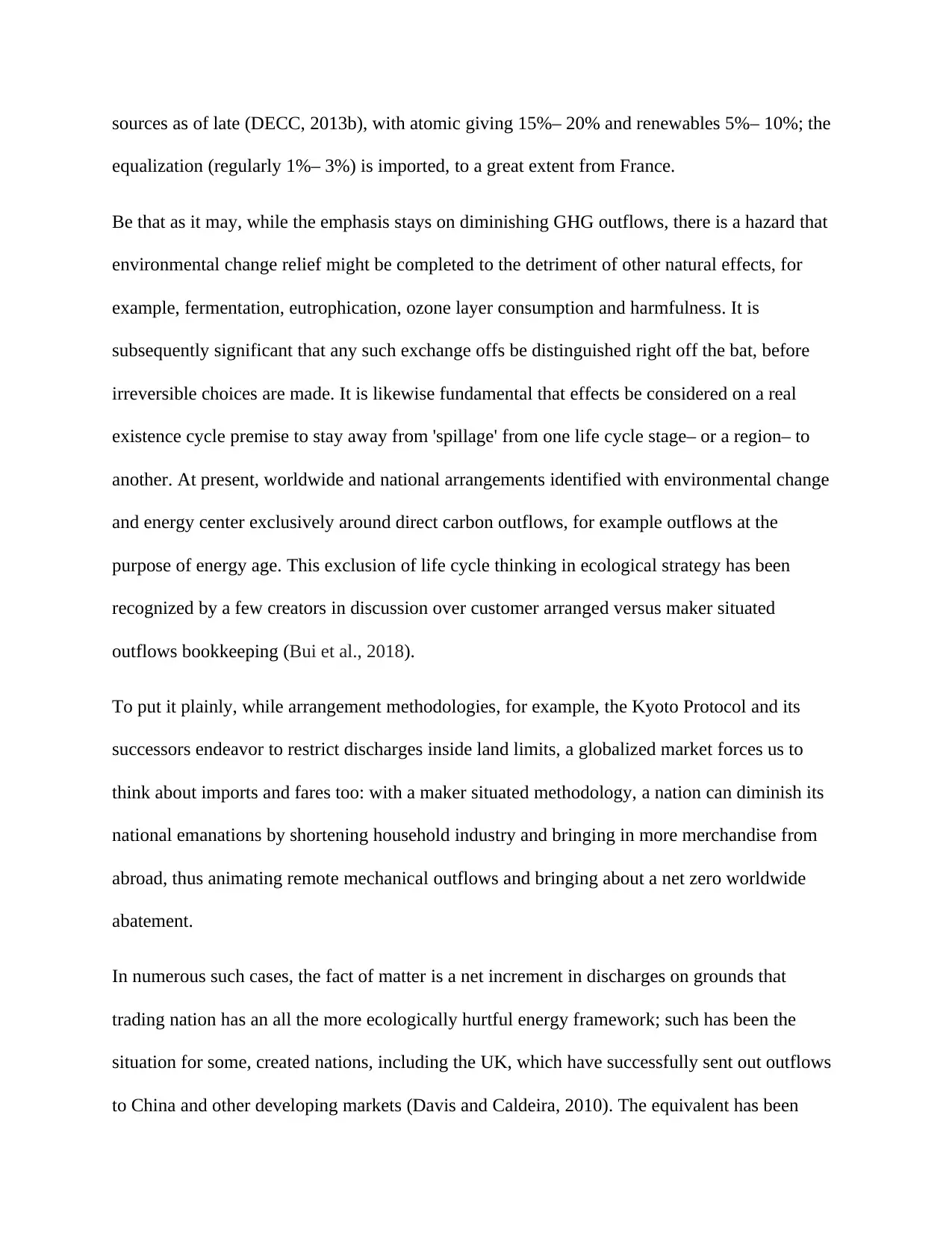
sources as of late (DECC, 2013b), with atomic giving 15%– 20% and renewables 5%– 10%; the
equalization (regularly 1%– 3%) is imported, to a great extent from France.
Be that as it may, while the emphasis stays on diminishing GHG outflows, there is a hazard that
environmental change relief might be completed to the detriment of other natural effects, for
example, fermentation, eutrophication, ozone layer consumption and harmfulness. It is
subsequently significant that any such exchange offs be distinguished right off the bat, before
irreversible choices are made. It is likewise fundamental that effects be considered on a real
existence cycle premise to stay away from 'spillage' from one life cycle stage– or a region– to
another. At present, worldwide and national arrangements identified with environmental change
and energy center exclusively around direct carbon outflows, for example outflows at the
purpose of energy age. This exclusion of life cycle thinking in ecological strategy has been
recognized by a few creators in discussion over customer arranged versus maker situated
outflows bookkeeping (Bui et al., 2018).
To put it plainly, while arrangement methodologies, for example, the Kyoto Protocol and its
successors endeavor to restrict discharges inside land limits, a globalized market forces us to
think about imports and fares too: with a maker situated methodology, a nation can diminish its
national emanations by shortening household industry and bringing in more merchandise from
abroad, thus animating remote mechanical outflows and bringing about a net zero worldwide
abatement.
In numerous such cases, the fact of matter is a net increment in discharges on grounds that
trading nation has an all the more ecologically hurtful energy framework; such has been the
situation for some, created nations, including the UK, which have successfully sent out outflows
to China and other developing markets (Davis and Caldeira, 2010). The equivalent has been
equalization (regularly 1%– 3%) is imported, to a great extent from France.
Be that as it may, while the emphasis stays on diminishing GHG outflows, there is a hazard that
environmental change relief might be completed to the detriment of other natural effects, for
example, fermentation, eutrophication, ozone layer consumption and harmfulness. It is
subsequently significant that any such exchange offs be distinguished right off the bat, before
irreversible choices are made. It is likewise fundamental that effects be considered on a real
existence cycle premise to stay away from 'spillage' from one life cycle stage– or a region– to
another. At present, worldwide and national arrangements identified with environmental change
and energy center exclusively around direct carbon outflows, for example outflows at the
purpose of energy age. This exclusion of life cycle thinking in ecological strategy has been
recognized by a few creators in discussion over customer arranged versus maker situated
outflows bookkeeping (Bui et al., 2018).
To put it plainly, while arrangement methodologies, for example, the Kyoto Protocol and its
successors endeavor to restrict discharges inside land limits, a globalized market forces us to
think about imports and fares too: with a maker situated methodology, a nation can diminish its
national emanations by shortening household industry and bringing in more merchandise from
abroad, thus animating remote mechanical outflows and bringing about a net zero worldwide
abatement.
In numerous such cases, the fact of matter is a net increment in discharges on grounds that
trading nation has an all the more ecologically hurtful energy framework; such has been the
situation for some, created nations, including the UK, which have successfully sent out outflows
to China and other developing markets (Davis and Caldeira, 2010). The equivalent has been
⊘ This is a preview!⊘
Do you want full access?
Subscribe today to unlock all pages.

Trusted by 1+ million students worldwide
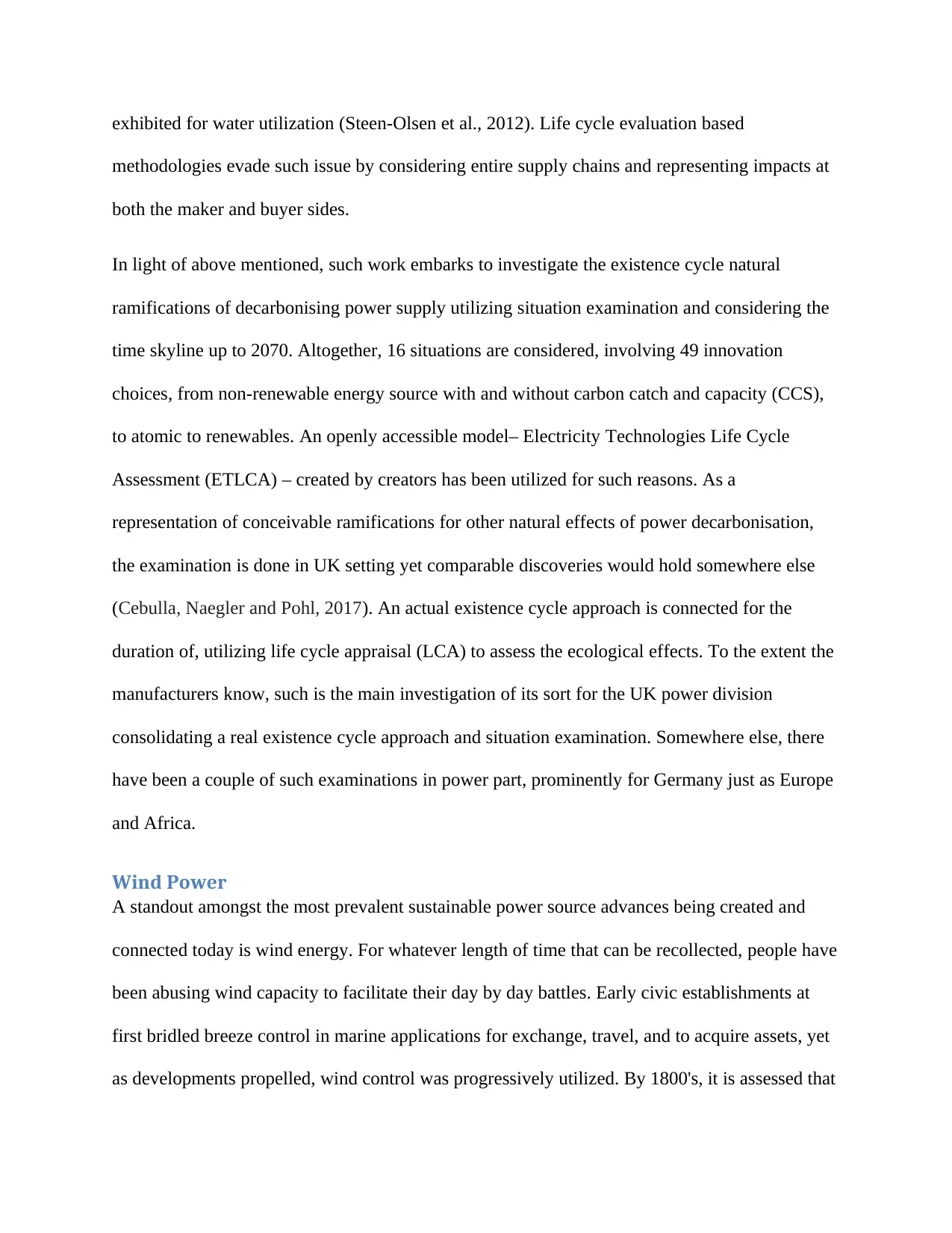
exhibited for water utilization (Steen-Olsen et al., 2012). Life cycle evaluation based
methodologies evade such issue by considering entire supply chains and representing impacts at
both the maker and buyer sides.
In light of above mentioned, such work embarks to investigate the existence cycle natural
ramifications of decarbonising power supply utilizing situation examination and considering the
time skyline up to 2070. Altogether, 16 situations are considered, involving 49 innovation
choices, from non-renewable energy source with and without carbon catch and capacity (CCS),
to atomic to renewables. An openly accessible model– Electricity Technologies Life Cycle
Assessment (ETLCA) – created by creators has been utilized for such reasons. As a
representation of conceivable ramifications for other natural effects of power decarbonisation,
the examination is done in UK setting yet comparable discoveries would hold somewhere else
(Cebulla, Naegler and Pohl, 2017). An actual existence cycle approach is connected for the
duration of, utilizing life cycle appraisal (LCA) to assess the ecological effects. To the extent the
manufacturers know, such is the main investigation of its sort for the UK power division
consolidating a real existence cycle approach and situation examination. Somewhere else, there
have been a couple of such examinations in power part, prominently for Germany just as Europe
and Africa.
Wind Power
A standout amongst the most prevalent sustainable power source advances being created and
connected today is wind energy. For whatever length of time that can be recollected, people have
been abusing wind capacity to facilitate their day by day battles. Early civic establishments at
first bridled breeze control in marine applications for exchange, travel, and to acquire assets, yet
as developments propelled, wind control was progressively utilized. By 1800's, it is assessed that
methodologies evade such issue by considering entire supply chains and representing impacts at
both the maker and buyer sides.
In light of above mentioned, such work embarks to investigate the existence cycle natural
ramifications of decarbonising power supply utilizing situation examination and considering the
time skyline up to 2070. Altogether, 16 situations are considered, involving 49 innovation
choices, from non-renewable energy source with and without carbon catch and capacity (CCS),
to atomic to renewables. An openly accessible model– Electricity Technologies Life Cycle
Assessment (ETLCA) – created by creators has been utilized for such reasons. As a
representation of conceivable ramifications for other natural effects of power decarbonisation,
the examination is done in UK setting yet comparable discoveries would hold somewhere else
(Cebulla, Naegler and Pohl, 2017). An actual existence cycle approach is connected for the
duration of, utilizing life cycle appraisal (LCA) to assess the ecological effects. To the extent the
manufacturers know, such is the main investigation of its sort for the UK power division
consolidating a real existence cycle approach and situation examination. Somewhere else, there
have been a couple of such examinations in power part, prominently for Germany just as Europe
and Africa.
Wind Power
A standout amongst the most prevalent sustainable power source advances being created and
connected today is wind energy. For whatever length of time that can be recollected, people have
been abusing wind capacity to facilitate their day by day battles. Early civic establishments at
first bridled breeze control in marine applications for exchange, travel, and to acquire assets, yet
as developments propelled, wind control was progressively utilized. By 1800's, it is assessed that
Paraphrase This Document
Need a fresh take? Get an instant paraphrase of this document with our AI Paraphraser
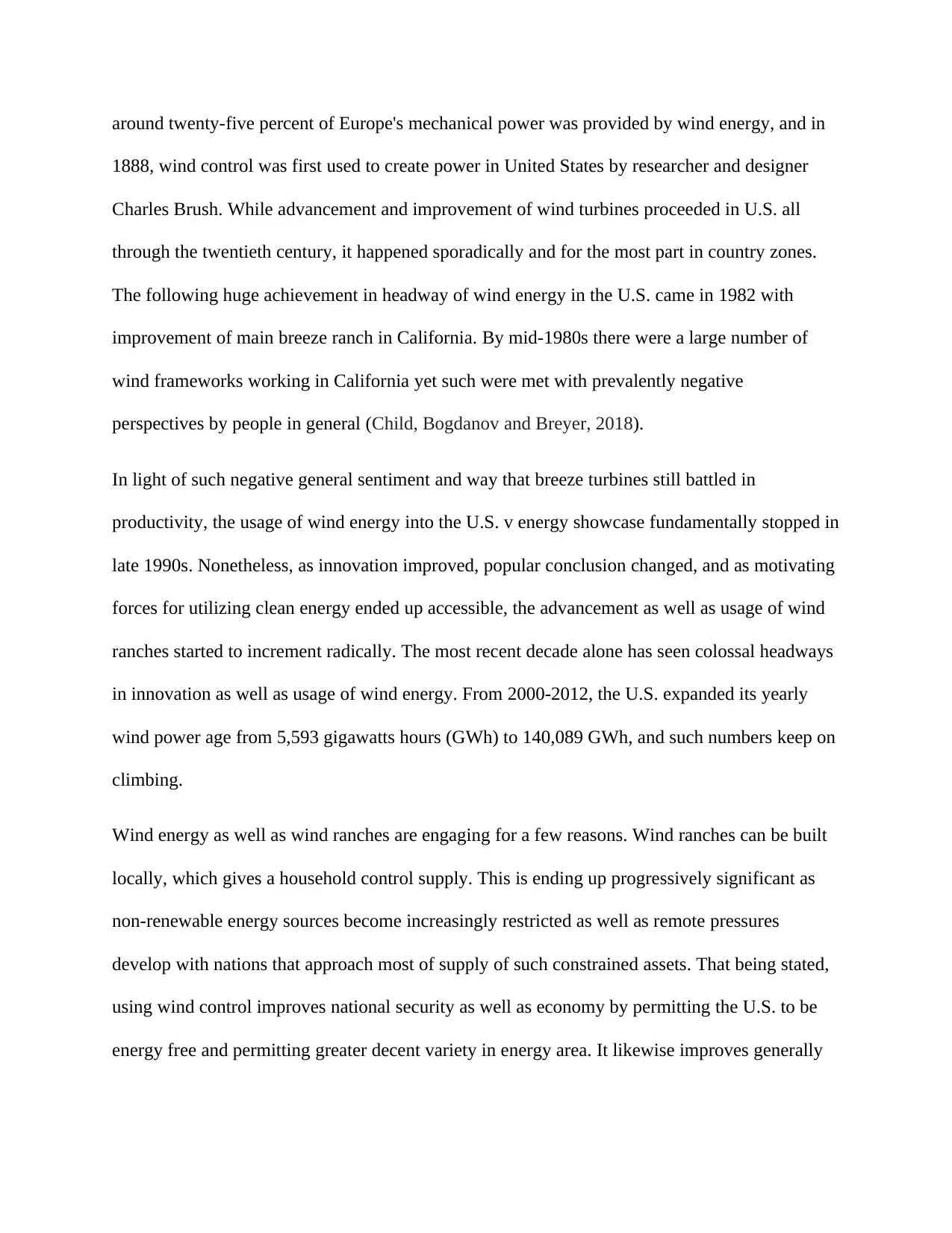
around twenty-five percent of Europe's mechanical power was provided by wind energy, and in
1888, wind control was first used to create power in United States by researcher and designer
Charles Brush. While advancement and improvement of wind turbines proceeded in U.S. all
through the twentieth century, it happened sporadically and for the most part in country zones.
The following huge achievement in headway of wind energy in the U.S. came in 1982 with
improvement of main breeze ranch in California. By mid-1980s there were a large number of
wind frameworks working in California yet such were met with prevalently negative
perspectives by people in general (Child, Bogdanov and Breyer, 2018).
In light of such negative general sentiment and way that breeze turbines still battled in
productivity, the usage of wind energy into the U.S. v energy showcase fundamentally stopped in
late 1990s. Nonetheless, as innovation improved, popular conclusion changed, and as motivating
forces for utilizing clean energy ended up accessible, the advancement as well as usage of wind
ranches started to increment radically. The most recent decade alone has seen colossal headways
in innovation as well as usage of wind energy. From 2000-2012, the U.S. expanded its yearly
wind power age from 5,593 gigawatts hours (GWh) to 140,089 GWh, and such numbers keep on
climbing.
Wind energy as well as wind ranches are engaging for a few reasons. Wind ranches can be built
locally, which gives a household control supply. This is ending up progressively significant as
non-renewable energy sources become increasingly restricted as well as remote pressures
develop with nations that approach most of supply of such constrained assets. That being stated,
using wind control improves national security as well as economy by permitting the U.S. to be
energy free and permitting greater decent variety in energy area. It likewise improves generally
1888, wind control was first used to create power in United States by researcher and designer
Charles Brush. While advancement and improvement of wind turbines proceeded in U.S. all
through the twentieth century, it happened sporadically and for the most part in country zones.
The following huge achievement in headway of wind energy in the U.S. came in 1982 with
improvement of main breeze ranch in California. By mid-1980s there were a large number of
wind frameworks working in California yet such were met with prevalently negative
perspectives by people in general (Child, Bogdanov and Breyer, 2018).
In light of such negative general sentiment and way that breeze turbines still battled in
productivity, the usage of wind energy into the U.S. v energy showcase fundamentally stopped in
late 1990s. Nonetheless, as innovation improved, popular conclusion changed, and as motivating
forces for utilizing clean energy ended up accessible, the advancement as well as usage of wind
ranches started to increment radically. The most recent decade alone has seen colossal headways
in innovation as well as usage of wind energy. From 2000-2012, the U.S. expanded its yearly
wind power age from 5,593 gigawatts hours (GWh) to 140,089 GWh, and such numbers keep on
climbing.
Wind energy as well as wind ranches are engaging for a few reasons. Wind ranches can be built
locally, which gives a household control supply. This is ending up progressively significant as
non-renewable energy sources become increasingly restricted as well as remote pressures
develop with nations that approach most of supply of such constrained assets. That being stated,
using wind control improves national security as well as economy by permitting the U.S. to be
energy free and permitting greater decent variety in energy area. It likewise improves generally
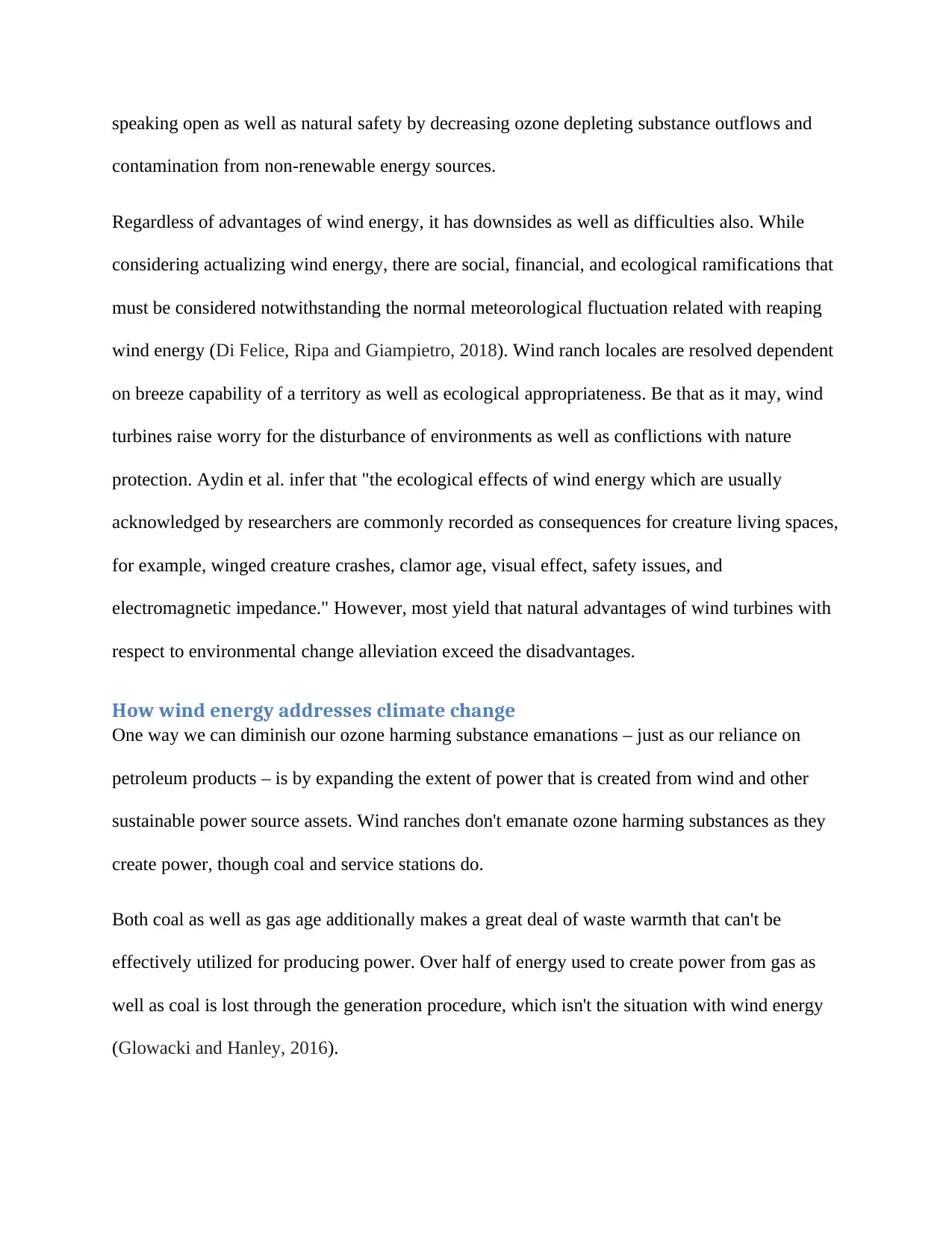
speaking open as well as natural safety by decreasing ozone depleting substance outflows and
contamination from non-renewable energy sources.
Regardless of advantages of wind energy, it has downsides as well as difficulties also. While
considering actualizing wind energy, there are social, financial, and ecological ramifications that
must be considered notwithstanding the normal meteorological fluctuation related with reaping
wind energy (Di Felice, Ripa and Giampietro, 2018). Wind ranch locales are resolved dependent
on breeze capability of a territory as well as ecological appropriateness. Be that as it may, wind
turbines raise worry for the disturbance of environments as well as conflictions with nature
protection. Aydin et al. infer that "the ecological effects of wind energy which are usually
acknowledged by researchers are commonly recorded as consequences for creature living spaces,
for example, winged creature crashes, clamor age, visual effect, safety issues, and
electromagnetic impedance." However, most yield that natural advantages of wind turbines with
respect to environmental change alleviation exceed the disadvantages.
How wind energy addresses climate change
One way we can diminish our ozone harming substance emanations – just as our reliance on
petroleum products – is by expanding the extent of power that is created from wind and other
sustainable power source assets. Wind ranches don't emanate ozone harming substances as they
create power, though coal and service stations do.
Both coal as well as gas age additionally makes a great deal of waste warmth that can't be
effectively utilized for producing power. Over half of energy used to create power from gas as
well as coal is lost through the generation procedure, which isn't the situation with wind energy
(Glowacki and Hanley, 2016).
contamination from non-renewable energy sources.
Regardless of advantages of wind energy, it has downsides as well as difficulties also. While
considering actualizing wind energy, there are social, financial, and ecological ramifications that
must be considered notwithstanding the normal meteorological fluctuation related with reaping
wind energy (Di Felice, Ripa and Giampietro, 2018). Wind ranch locales are resolved dependent
on breeze capability of a territory as well as ecological appropriateness. Be that as it may, wind
turbines raise worry for the disturbance of environments as well as conflictions with nature
protection. Aydin et al. infer that "the ecological effects of wind energy which are usually
acknowledged by researchers are commonly recorded as consequences for creature living spaces,
for example, winged creature crashes, clamor age, visual effect, safety issues, and
electromagnetic impedance." However, most yield that natural advantages of wind turbines with
respect to environmental change alleviation exceed the disadvantages.
How wind energy addresses climate change
One way we can diminish our ozone harming substance emanations – just as our reliance on
petroleum products – is by expanding the extent of power that is created from wind and other
sustainable power source assets. Wind ranches don't emanate ozone harming substances as they
create power, though coal and service stations do.
Both coal as well as gas age additionally makes a great deal of waste warmth that can't be
effectively utilized for producing power. Over half of energy used to create power from gas as
well as coal is lost through the generation procedure, which isn't the situation with wind energy
(Glowacki and Hanley, 2016).
⊘ This is a preview!⊘
Do you want full access?
Subscribe today to unlock all pages.

Trusted by 1+ million students worldwide
1 out of 48
Related Documents
Your All-in-One AI-Powered Toolkit for Academic Success.
+13062052269
info@desklib.com
Available 24*7 on WhatsApp / Email
![[object Object]](/_next/static/media/star-bottom.7253800d.svg)
Unlock your academic potential
Copyright © 2020–2025 A2Z Services. All Rights Reserved. Developed and managed by ZUCOL.




